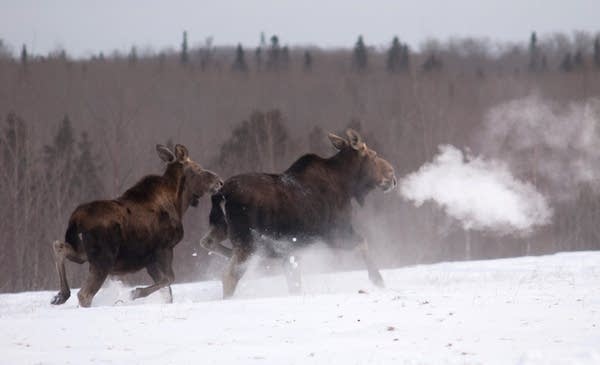To save moose, coalition spends millions on habitat

Aiming to help save Minnesota's endangered moose population, a coalition of groups is spending nearly $3 million to restore the animal's habitat in northeast Minnesota.
The number of moose in Minnesota has fallen to 3,450, down from 4,350 in 2014, according to the state Department of Natural Resources. Since 2006, the moose population has dropped by 60 percent.
To make sure the moose have the food and shelter they need to survive, workers hired by Lake County are planting slender cedar and white pine seedlings in a clearing of a remote forest north of Finland.
Moving quickly, each worker is planting about 3,000 conifer trees a day.
Create a More Connected Minnesota
MPR News is your trusted resource for the news you need. With your support, MPR News brings accessible, courageous journalism and authentic conversation to everyone - free of paywalls and barriers. Your gift makes a difference.
"Eventually, in 15 to 20 years, they're going to be high enough to provide shade for moose," said Ron Moen, a professor and moose researcher at University of Minnesota Duluth.

Moose need those big trees to stay cool. But they also need food. That's why before the seedlings were planted, winter crews first sheared the brush down to the ground. When it sprouts again, it will grow low enough for moose to eat for several years.
"You can see with the shearing that went on, there's food that's within reach of moose," said Moen, who works at UMD's Natural Resources Research Institute.

Moen said moose require a patchwork of two very different kinds of habitat across the landscape.
"They need mature forests and they need younger forests," he said. "Mature forest is for shelter; younger forest is for food."
But that young forest is getting harder for moose to find in Minnesota.
Mike Schrage, a wildlife biologist for the Fond du Lac Band of Lake Superior Chippewa, blames two factors: a decline in logging and an aggressive approach to putting out most wildfires. Without those disturbances, he said, there aren't many places for new trees to sprout.
"Moose need good places to eat and cover to make a living," Schrage said. "We need to act quickly and aggressively if we're going to turn our moose numbers around."
Scientists don't know exactly what's behind the precipitous drop in moose numbers in Minnesota. They suspect it's a combination of climate change, disease and parasites, predators and habitat loss.
That's where the tree-planting project comes in. A collaborative between a number of government agencies, tribes and nonprofit groups like the Nature Conservancy and the Minnesota Deer Hunters Association, it aims to improve habitat — the one factor that land managers can control.
With funding from the state's Legacy Amendment sales tax, they plan to treat about 8,500 acres across northeast Minnesota. To create new habitat, workers will use prescribed burns, remove brush, plant trees and harvest timber.

On a recent visit to the forest, Schrage noted clear indications that new habitat is needed. He said moose have been feeding on some trees for years.
"Some of these branches back here [are] broken off six feet off the ground," he said. "That's moose grabbing twigs and pulling the branch over to get what they want. And sometimes individual trees in certain locations are just like ice cream for moose, and they just keep coming back and hitting it year after year."
The hoof prints in the mud and chewed aspen trees that Schrage and others saw on a recent visit to the area are signs that moose are still in Minnesota forests.
But Schrage worries it could be difficult to evaluate the habitat restoration projects.
Earlier this year, Gov. Mark Dayton issued an executive order that banned placing GPS collars on moose. Dayton said he was concerned that collaring had led to the deaths of some adult moose and put calves in danger of abandonment by their mothers.
The collars had allowed researchers to track the kind of habitats moose visited.
"We're putting a lot of effort into habitat management, a lot of time and a lot of money," Schrage said. "We need to be able to know that it's working."
The GPS collars allow researchers to determine if moose are still in the area and for how long, he said. They also help determine if moose survival rates are improving because of the restored habitat.
"Getting those kinds of answers is a lot harder to do without a lot of research," he said. "And a lot of that is best done with collared animals."
Schrage said the habitat collaborative is a good start. But the 8,500 acres it plans to treat is a tiny fraction of the hundreds of thousands of acres of moose habitat in the state. If the climate continues to warm significantly, he said, it might not matter how much habitat is created.
Still, Schrage and others say it's worth the effort. The Minnesota Deer Hunters Association backs the project because it also will create better habitat for deer and other species, said Craig Engwall, the group's executive director.
"So yes, it's a good amount of money, but an important amount of money, and an investment in trying to save an iconic species in Minnesota," Engwall said.


